The usual life changes if a small fluffy ball appears in the house. Future owners are really looking forward to this day to give their new family member their affection and care. However, before adopting a baby, it is worth considering that the optimal age when you can take a kitten from a cat is 2.5–3 months.
- Skills that a cat passes on to a kitten
- If you pick it up too early
- Gradually separate mother and child
Kitten development stages
The first two months after birth, the kitten is very dependent on the mother cat, who teaches him all the basic skills for independent life: feeding, moving, defecating, licking himself and ensuring safety.
A helpless newborn takes all this from his mother, from whom they cannot be separated immediately under any circumstances. Therefore, before taking a kitten into your home, it is better to find out what age it is and whether it still lives with its mother.
Let's look at the main stages of kitten development:
0–1.5 week
Kittens are born blind, cannot keep their balance and move freely, so they spend the first week and a half from birth clinging to their mother and only trying to crawl next to them. At first, babies are not able to empty their bowels on their own, so their mother cat helps them cope with this task.
1.5–3 weeks
During this time, the babies grow quite a lot - they become three times larger and reach 300–400 grams in weight. Kittens begin to see the world around them with their own eyes, which are already opening, but are not yet able to keep focus on objects. The third week ends with teething and the first confident steps.
3–6 weeks
During these twenty days of life, the fluffy ball demonstrates independent orientation and confident movement in space. The kitten continues to grow teeth, the number of which reaches twenty-six. You can start feeding a one-month-old kitten with solid food and gently pick it up for a short while - the cat also needs rest and is unlikely to mind, because the baby has already grown up.
6–12 weeks
The baby continues to grow up and master all the necessary key skills for the transition to a full independent life. The kitten's mouth is now just like an adult's - all its teeth grow, so its nutrition consists almost entirely of solid food. The kitten’s body becomes more developed, stronger and able to withstand vaccination. Therefore, at this time the baby is taken to the veterinarian for the first vaccination.
12 weeks and older
By three months, a kitten has usually reached the peak of its development and is ready to begin adulthood. They develop immunity, develop character, and show curiosity and playfulness. The transition from mother's milk and mixed nutrition to only solid food is completed.
It is at this time that the period begins when kittens can be separated from the cat and given to new owners, where they can live without their mother and her help.
Bowls and food
You will need a bowl for water and two more for food. The bowl for water should be deep, for dry food - medium depth, for wet food you can choose flatter bowls. However, do not buy bowls that are too deep - it will be difficult for a small kitten to eat and drink from them. The bowls you buy for your baby should under no circumstances be plastic: they are absolutely not hygienic.
First of all, you should buy high-quality dry food for kittens. You can feed the kitten only wet food, but it is more expensive: if the kitten doesn’t finish it, you will have to throw everything away. It is recommended to mix wet and dry food in the diet in a 1 to 1 ratio: for example, give wet food for breakfast, and feed dry food for the rest of the day.
The water in the bowl should not be stagnant: it must be changed every day!
Why you can’t separate a newborn kitten from its mother
First of all, this can have a bad effect on the health of both mother and baby. At this time, the newborn and his parent are going through (both physically and emotionally) a very stressful period, both instincts are acutely triggered, so separation can have a strong negative effect and become too much stress for them. Such trauma can affect a pet's continued physical and emotional well-being throughout their life.
In addition, a kitten that has just been born is a helpless creature, incapable of independent life. Therefore, until the cat teaches him all the essentials and until his body reaches a certain stage of development, they cannot be separated. If you want your future pet to be healthy and developed, do not take a newborn kitten home, let it grow and get stronger.
Skills that a cat passes on to a kitten
The cat takes care of her cubs from birth and gradually teaches them everything they need for life so that they can cope on their own. Therefore, kittens are separated from the cat at three months of age, when they have learned all of the following:
- The first skills that kittens learn when their eyes open are walking on their four legs and reacting to the appearance of strangers and possible danger.
- Mom teaches not only how to “prick up your ears,” but also how to interact with people, animals and objects. Behavioral skills instilled by a cat mother help the baby adapt to different situations and prepare for further independent existence.
- A cat begins to learn the basics of personal hygiene when her child reaches one month of age. She shows how to properly wash your face, groom yourself thoroughly, and thoroughly brush your fur. The kitten also learns hygiene procedures after eating and going to the toilet.
- The kittens, which are stronger by the month of birth, following their mother’s example, learn to walk around, exploring the territory of the home. Exploring new territories, a necessary skill for any animal, is also passed on from a mother cat to her babies.
- Another important skill for a pet is to go to the toilet in a certain place. Using her personal example, the cat shows the cubs that they need to relieve themselves and empty their intestines in a special tray.
Having learned these lessons from the parent and mastered key skills for adulthood, the kitten is able to move on with its life on its own.
Hurry up, choose a box and find out what gift awaits you
Discount on pet insurance
Promo code copied to clipboard
Relationships with family
You need to start building good relationships with all family members from day one. Obviously, the first approach is for someone to take the cat home. Ideally, take it in a pet carrier so you can feel safe without being forced to carry it by an unknown person. On the way home, talk to your kitten in a soft and reassuring tone. Let him sniff the mesh of the carrier and respect his decision if he wants to stay down.
When you get home and leave him in the room we described, let him decide when to leave the carrier, don't force him to do it. Stay tuned as you do this, letting him sniff, and back off if you notice he's getting too tense. Give him time to explore the room alone, and then return. If you notice that he is calmer, sit on the floor so as not to scare him with your height, and remain still so that he only approaches you when he wants to.
Most likely it's good to sniff. Let him do this a couple of times before you try petting. Keep some tasty food nearby to offer as a reward, this way your kitten will understand that being with you brings good things. And when the cat is comfortable with you, other family members can use the same method to identify their scents and not be caught off guard by encountering them in the rest of the space.
shutterstock
When can you take kittens away from your cat?
It is believed that at the age of three months a kitten can be taken away from a cat, since it is already sufficiently developed and has the necessary skills to live without its mother. However, this general recommendation is not necessarily the only correct solution. When breeders decide whether kittens can be given away to new owners, they do not count the number of days or months that have passed since their birth. The main guideline is their ability to independently cope with daily cat activities and needs.
Let's list the main things a kitten should be able to do in order to calmly go to live in a new home:
- stand firmly on your feet and move around;
- absorb solid food without assistance;
- associate the tray with a place to go to the toilet;
- lick yourself regularly and as needed.
The baby gains experience and the listed skills from the cat in its first 12 weeks, so that after 3 months from the moment of birth the kitten can already be taken to a new family.
If you pick it up too early
Sometimes breeders offer to pick up a kitten only 1 month after birth, but is this possible and what is the threat to the baby? It is possible if the pet is an orphan. If he has a mother, then you should wait another 1.5–2 months, otherwise you can ruin the baby’s life.
Firstly, physiological problems may begin. Mother's milk, which kittens are fed from birth until they are fully accustomed to solid food, is a necessary source of nutrition for a newborn at first. It contains special enzymes on which the baby’s proper digestion and immunity depend. Deprived of the opportunity to receive beneficial microelements from the mother's milk, the kitten will begin to experience problems with digestion and stool, and dysbacteriosis and diarrhea may develop. In addition, at first he is simply not able to eat solid food.
In addition to gastrointestinal problems, a weaned kitten is at risk of contracting an infection because without the nutrients contained in mother's milk, its immunity is compromised.
Secondly, the emotional health of the small animal will suffer. The kitten's attachment to its mother cat is especially strong in the first month and a half, so if you tear it away from the most important object in its life, psychological and behavioral problems may begin. The extreme stress that a kitten may experience in this case can, in turn, cause other health problems.
If it's too late to pick up
It's never too late to take your pet into good hands, but if you do this after 7-8 months from birth, a number of problems may arise. Firstly, the longer the baby stays in one place, the more he gets used to it - a certain behavior pattern and daily routine develops, so it is more difficult for him to adapt to a new way in the house of a different owner. Secondly, with the onset of puberty, the pet begins to undergo hormonal changes and changes in the body - the pet becomes an adult. This is a new and restless period in the animal’s life, so at this time it is better to keep it in a comfortable, familiar atmosphere and not expose it to additional stress. Therefore, to keep kittens healthy and happy, they can be given away at three months and until puberty begins.
Cat etiquette rules
Also, up to 3 months, the mother still teaches the kittens the rules of etiquette - using a scratching post, a tray and other points, for example, not to let out their claws during play. A person can teach this, but it’s more difficult for him to do it than for his mother. A person without experience raising cats will have a hard time. If you do not want to have problems with such basic rules of cat life, as well as with the manifestation of infantile behavior in an already adult cat (for example, sucking human clothes and hair and similar oddities), you need to adopt a kitten at an older age.
How to ensure a smooth transition to a new home?
Owners should take care in advance so that when the time comes to separate the kittens from the cat for good, they can be given into new hands without harm to the mother and her cubs. Here are key tips you can follow to ensure a smooth transition for your pet to a new home.
Gradually separate mother and child
It is worth starting the baby’s adaptation to life without a mother gradually. So, after 4 weeks, he is weaned off his mother’s milk, giving him a little complementary food (wet food, low-fat fermented milk products and tender chicken). Also, the woman in labor and her offspring are separated for short periods of time, placing the baby in a nook with its own tray and bowl. A substitute for mother's milk is poured into a bowl and the kitten is taught to lap from there on its own.
Take care of your sad mother
By regularly taking away babies who have achieved basic independence for a while, you will get the mother accustomed to their subsequent absence. This will also affect the amount of milk produced by her body, so that the level of nervous tension of the mother will gradually decrease. Without sensing the smell of a child nearby, his mother will not feel an instinctive urge to find her child.
When the house is empty, the female will begin to feel sad and vocal - at this moment it is important to support her in every possible way: please her with treats and distract her from sadness with games. Gradually she will get used to the new circumstances and return to normal life.
Prepare a feeding area
Decide in advance where your new pet will eat and place separate bowls for food and water in this place. The location of the bowls should be such that nothing interferes with him while eating.
Set up a sleeping area
More than eating, our smaller furry brothers love to sleep. Therefore, it will be better if by the time the baby arrives in the house, he will have already been allocated a special comfortable place to rest and sleep. It is good if the bed is placed so that he can see what is happening around him - curious predators like this.
Choose the right food
The new owner should ask the current owner of the kitten in advance what kind of food he gives him, and make sure that it is suitable for the ward. If everything is in order, you should not immediately switch him to other foods; it is better to do this a little later, when he adapts to the new place. If not, be sure to choose one that is suitable for age, breed and other characteristics.
Place a convenient tray
Choose a tray for your child so that it is convenient for him to get in and out of it. Place it in the most suitable place for this purpose. Also, choose a high-quality litter for the litter box so that your pet can go to the toilet comfortably.
Hang a nail sharpener
Don't forget that your new friend, although small, is still a predator. And even though his claws are not yet as strong and long as those of an adult, they still need to be sharpened regularly. Yes, and the pet will manifest these instincts. So buy and place a scratching post in a suitable place.
Natural food recipes
There are two options for feeding natural food: monofeeding and mixes. Monofeeding involves eating one or two types of meat, usually in noticeably large pieces. Mixes are mixtures of different types of meat and offal with other ingredients. Before serving, the meat is frozen in the freezer for at least 3 days in portioned bags. Before serving, defrost and warm naturally to room temperature. If you need to heat it up quickly, you can put the bag in water at room temperature.
A scheme that you need to follow to plan the diet and ensure that the cat is always fed.
- We plan the menu a week or two in advance, if freezer space allows. We calculate how much a cat should eat per day, multiply by the number of days for which it should be enough. From this number of kilograms we calculate how much muscle meat and hearts should be, how many organs, how many meat bones and how many vegetables. Convert percentages to grams (kilograms). Based on this, we write a shopping list. It is not necessary to calculate down to the gram; an approximate proportion is sufficient. For example, a cat weighs 5 kg, 5% per day of his body weight = 250 g. To create a menu for a week, you need to multiply 250 g by 7 days, we get 1750 g. Of this, a third (about 580 g) are meat bones, half (875 g) is muscle meat, the rest (about 300 g) is organs or organs with a pinch of grated vegetables. Based on this, you need to buy, for example, 580 g of chicken necks, 875 g of hearts or thighs and 300 g of stomachs at the market or supermarket. It is enough to calculate the proportion once and follow it. If the animal is growing, then we weigh it every week and adjust the numbers.
- We go to trusted retail outlets or order the required amount of products on the Internet. We stock up on small bags or containers for laying out the meat.
- If we make mixes, then we throw in muscle meat, meat bones and organs, and vegetables. All this can be pre-ground in a meat grinder or cut into small pieces, or you can leave it in the form of large pieces if the cat can chew them. When monofeeding, we do the same thing, only we put one or two types of meat in each bag. We weigh each bag on a kitchen scale. One packet can equal one serving or a daily serving for two meals.
- We put the bags in the refrigerator. It is advisable to write on them the start date of freezing or mark it somewhere so as not to forget.
- When the right time comes, take out the bag and defrost the meat. Serve your cat food at room temperature.
- When there are 3-5 bags left in the freezer, we do everything again: buy, chop, freeze.
To make it easier to create a menu, here are recipes for natural food for cats. Each owner can make his own using the correct proportions. But there are also ready-made ones from specialists.
Assorted
Turkey legs - 1 kg, heart (pork, beef, chicken, turkey) - 1 kg, turkey liver, beaten and cut chicken necks - 1 neck per bowl, grated seasonal vegetables (for example, carrots or pumpkin) - pinch, dried kelp (added just before serving).
Chicken mix
Chicken thigh meat - 25%, chicken breast meat - 25%, chicken backs and necks twisted in a meat grinder - 25%, chicken heads twisted in a meat grinder - 5%, chicken liver - 5%, chicken hearts and gizzards - 10%, cauliflower - 1%, grated pumpkin - 1%, grated cucumber - 1%, grated apple - 1%, kelp (dried seaweed) - 0.3%, piece of trout - 1%.
Turkey mix
Turkey thigh meat - 25%, turkey breast meat - 25%, turkey necks - 30%, turkey heart - 5%, turkey gizzards - 10%, cauliflower - 1%, pumpkin - 1%, zucchini - 1%, apple - 1%, lingonberry - 0.5%, kelp - 0.3%, trout oil - 0.2%.
Healthy cats should not be served meat in the form of soups, broths, minced meat or pate. The cat should eat pieces - small, medium or large. Large ones are preferable if the cat can handle them.
EXPERT COMMENT: VETERINARIAN-FELINOLOGIST YULIA BROVKO
Carrying
In order to transport a kitten from a breeder or its previous owner, a carrier is required. Don’t think that it’s easy to carry a cat in your bosom: he may get scared of something on the street, break free and run away. In the future, this accessory will help you when visiting a veterinarian or an exhibition, or when traveling with your pet. There are two types of carriers: plastic and fabric.
You should choose a hard plastic one if you are going to fly with your pet, as this is what the rules for transporting animals require. This type of carrier is also safer for transporting an animal by car. However, such a carrier will have to be insulated separately.
Soft fabric is more convenient if you plan to carry the cat yourself, on foot or by public transport. The disadvantage of this type of carrying is the need for washing.
What to feed a stray cat from the street
First of all, the new owner, who picked up the kitten on the street, wants to fatten it. Such “nutritional acquaintance” will instill trust in the animal. From the gastronomic abundance you can use:
- Any industrial food, depending on the condition of the teeth - dry or wet. If there is no wet one, you can soak the dry one in water.
- Meat baby food, baby cottage cheese without salt or fillers.
- Chopped meat of chicken, turkey, rabbit, as well as beef, boiled or raw (scalded with boiling water).
In addition, pork contains the enzyme thiaminase, which destroys vitamin B1. It is destroyed by heat treatment, but fried meat is not suitable food for a kitten.











